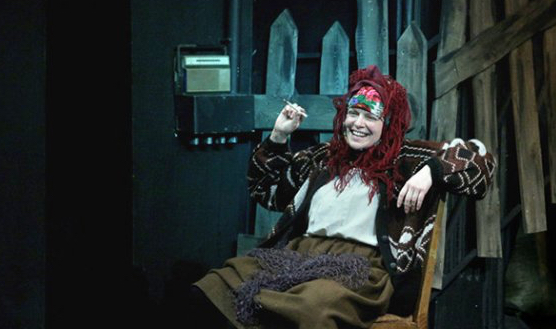Friday, August 10, 2018 |
Volodymyr Tykhy’s “Brama”. A Review
|
| |
August 10, 2018. A few weeks ago, I went to see Volodymyr Tykhy’s Brama (Ukrainian: Брама) on an incredibly last-minute whim. Interrupted during a Skype call on one of my last days in Lviv, I was promised that the film had received rave reviews and that I had to see it because it was actually a Ukrainian-made film, not just another Ukrainian-dubbed Hollywood hit. And so I wrapped up my Skype call and headed to the cinema, knowing nothing other than that the title Brama meant ‘gate’ or ‘portal,’ a tidbit I had learnt a few weeks prior when reading up on the Zaborovskyi Gate at St. Sophia’s Cathedral in Kyiv.
I’ll admit right off the bat that my knowledge of Ukrainian and Russian combined was not always enough to understand every line of dialogue in the film. Nevertheless I was able to understand the better of the plot despite the characters speaking with dialectical quirks and surzhyk. Tykhy’s Brama centers on a three-person and three-generational family residing in the Chornobyl Exclusion Zone in present-day Ukraine. At the head of this family is Grandmother Prysia, a seasoned veteran of many life struggles, including Nazi invasion. Grandmother Prysia’s daughter, Slava, on the other hand, is of weak character and is depicted as sickly, lazy, and shameless. She is a symbol of the new, ‘lost’ generation of Ukraine. Slava’s husband, and father of her son Vovchyk, long ago deserted the family. His disgust at his life, his wife, and Vovchyk who suffers from some unspecified mental handicap propelled him to leave the Exclusion Zone.
What I found rewarding in watching Brama was that it exposed me to certain historical and sociological phenomena in Ukraine that I had previously only read about from the safe and unreal distance of the internet. For example, as an American it was valuable to see footage (be it dramatized or not) of Ukrainians making the decision to move back into the Exclusion Zone, living and struggling there, and having intergenerational divides that cause serious familial tensions.

Nevertheless, I felt the film was a carousel of different tropes, and I can only imagine that these tropes are even more overdone for a Ukrainian viewer who has seen more Ukrainian films, read more current Ukrainian literature, and is generally more familiar with the current arts scene in Ukraine today. The first and most permeating trope is that of Chornobyl voyeurism. In his own way Tykhy tries to pick up on the current real trend of Chornobyl tourism, but it comes of a bit stale and overworked. The insight into returning locals (Grandmother Prysia and her family) is not revealing of any deeper, more powerful reality of their lives or suffering. As for the flair of violence when the bandit-tourist shoots — or rather, hunts — Vovchyk like an animal in the Exclusion Zone, the imagery falls flat and ambiguous. Why is Vovchyk (a name which means little wolf) being hunted? Is this commentary against predatory tourism and scavenging off the suffering of fellow compatriots? Again, Tykhy’s attempt to achieve some powerful message through some poignant vignette falters.
The second trope that perhaps could have been the most rewarding, but ended up detracting most from the film, was the folkloric elements such as the rusalka, the magic mushroom, and the pagan witchcraft. It was a Dakha Brakha of cinematography, but with far less success. It felt cheap, and not simply because the special effects left something to be desired. The rusalka, essentially unnecessary to the plot, more than an attempt to incorporate more native, Slavic features to the film, was a bombastic visual experimentation. It looked more like something out of Cameron’s The Abyss (1989) than akin to prior representations of a this mermaid-like creature in slavic mythology. The magic mushroom which Grandmother Prysia ingests to initiate a pagan ritual to save her family, while instrumental in developing the plot, pushed the film too close to fairy tale. While a fairy tale of a film isn’t inherently bad, this didn’t mesh with the film’s direct grappling with the modern world. Instead the magic-mushroom moment felt like an odd scramble of the Slavic fern flower myth meets postmodern psychedelics. The grave proclamation of the mushroom appearing only “once in a hundred years,” left a sour, rather than psychedelic, taste on the tongue.
In the end, I walked away from the film — particularly from the culmination of Grandmother Prysia’s witchcraft which transitions to an intergenerational subway-scene conclusion — utterly confused as to what message I could even concoct that would help string together the scenes I had just witnessed. Was I to pity those who had decided to return to the Exclusion Zone? Or to judge them? Was I to leave the theater angry with the Ukrainian government’s inefficacy and corruption? Thus, while Tykhy’s Brama injects viewers with many important questions about modern Ukrainian society and life, it fails to leave any indelible mark or any concrete understanding. This, in turn, makes the film a bit forgettable and weak and the whole. To be perfectly frank, I think the only relevant lasting image from the film is that of Vovchyk being hunted and shot at. Among the irrelevant but lasting images, most prominent is that of an ancient Ukrainian grandma ingesting magic mushrooms. I feel quite confident that while the critical issues Tykhy aimed to address in Brama will remain dusty objects in the attic for some time more, the image of Baba Prysia and her magic mushrooms has already been codified into modern society as a wonderful meme or eternally repeating GIF.
Ainsley Katz,
Columbia University
Film trailer >>>
|

